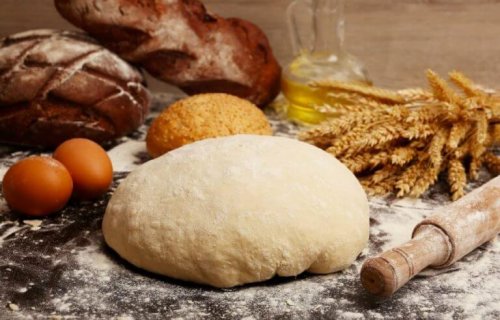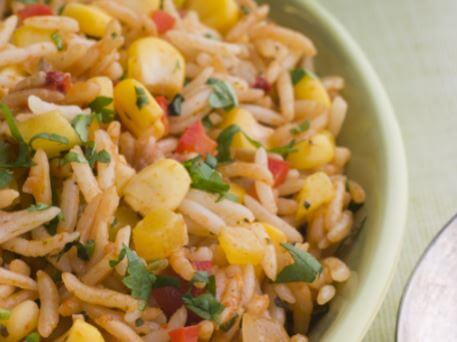Whole Grain Recipes and Their Benefits

An increasing number of people are now avoiding processed foods and relying more on healthier alternatives. Thus, the whole grain recipes we will see in this article are examples of foods that give us the nutrients and fiber that our bodies require.
Looking at whole grains from a nutritional point of view, we notice that they’re packed full of minerals such as magnesium, manganese, iron, selenium, phosphorus, and zinc. However, these miracle foods are more than just minerals, they also provide our diets with vitamin B.
Consequently, vitamin B is a key component in our diets and supplies our nervous systems and ensures the proper performance of our metabolism with the right nutrients.
Types of whole grains
Within all the different types of whole grains, we may categorize them in two groups: those with gluten and those without. And so, the cereals with gluten are:
- Rice and all its varieties
- Corn
- Polenta
- Millet

On the other hand, some of the whole grains that do contain gluten are the following:
- Oat
- Barley
- Rye
- Wheat and all its varieties
- Semolina
- Couscous
Whole grain recipes
We can make quite a large variety of meals with whole grains, whether we have a sweet tooth or not. And so, we can include these whole grain recipes in our breakfasts, lunches, dinners and even in our snacks.
Here are two of the best whole grain recipes that we are sure you’ll love and that will make your diet a little healthier.
Whole grain bread
One of the most popular of all the whole grain recipes, possibly for its simplicity, is whole grain bread. Consequently, this is a common food in every household and it’s easy to include in our regular diets.
Ingredients:
- 2 cups of whole grain flour
- 1 cup of warm water
- 3 tablespoons of oil, olive oil if possible
- Yeast
- Sal to taste
- 3 tablespoons of chia seeds, flax seeds and/or sunflower seeds. (optional)

Directions:
- Preheat the oven to 430 degrees F.
- To make the dough, put the flour and salt in a bowl.
- Dissolve the yeast in 1/2 a cup of warm water.
- Add this liquid to the dry ingredients in the bowl gradually. Mixing the yeast slowly, along with the oil and the rest of the warm water. Mix and knead until you have a smooth and uniform dough.
- Add the seeds and mix until fully included in the dough.
- Make bread rolls, cover them with a cloth and let it ferment in a warm place until it doubles in volume. Somewhere between half an hour to one hour.
- Oil and flour a baking tray.
- Place the bread rolls on the tray. Make sure they are at least one-centimeter apart (half an inch) so that they have enough space to grow when baking.
- Bake for 50 minutes, or until they are golden. Let them cool before eating them.
Yamani rice wok
Likewise, we can start substituting other whole grains in our meals, such as whole grain rice. Thus, this is also a common food in many households and a great source of fiber.
Ingredients:
- 1 cup of Yamani rice
- 1/2 a large onion, or 1 medium sized onion
- 1 medium-sized carrot
- 1 red bell pepper
- Half a cup of soy sauce
- 3 tablespoons of olive oil
- 1 tablespoon of sesame seeds
- Salt and pepper to taste

Directions:
- Boil water in a cooking pot, use two cups of water for every cup of Yamani rice.
- Then, add the Yamani rice to the water and also add a pinch of salt. Let it boil on high heat with the pot covered. Then, once the water is boiling, lower the heat to medium, and let boil for 25 minutes.
- While the rice is cooking, cut the vegetables into long thin Julienne strips.
- Sautee the vegetable strips in a wok with oil until they are tender.
- Once the rice is cooked, mix it in the wok with the vegetables.
- Add salt and pepper to taste.
- Then, add soy sauce and mix.
- Finally, serve the rice mixture on flat plates. And lastly, decorate the plate with sesame seeds.
An increasing number of people are now avoiding processed foods and relying more on healthier alternatives. Thus, the whole grain recipes we will see in this article are examples of foods that give us the nutrients and fiber that our bodies require.
Looking at whole grains from a nutritional point of view, we notice that they’re packed full of minerals such as magnesium, manganese, iron, selenium, phosphorus, and zinc. However, these miracle foods are more than just minerals, they also provide our diets with vitamin B.
Consequently, vitamin B is a key component in our diets and supplies our nervous systems and ensures the proper performance of our metabolism with the right nutrients.
Types of whole grains
Within all the different types of whole grains, we may categorize them in two groups: those with gluten and those without. And so, the cereals with gluten are:
- Rice and all its varieties
- Corn
- Polenta
- Millet

On the other hand, some of the whole grains that do contain gluten are the following:
- Oat
- Barley
- Rye
- Wheat and all its varieties
- Semolina
- Couscous
Whole grain recipes
We can make quite a large variety of meals with whole grains, whether we have a sweet tooth or not. And so, we can include these whole grain recipes in our breakfasts, lunches, dinners and even in our snacks.
Here are two of the best whole grain recipes that we are sure you’ll love and that will make your diet a little healthier.
Whole grain bread
One of the most popular of all the whole grain recipes, possibly for its simplicity, is whole grain bread. Consequently, this is a common food in every household and it’s easy to include in our regular diets.
Ingredients:
- 2 cups of whole grain flour
- 1 cup of warm water
- 3 tablespoons of oil, olive oil if possible
- Yeast
- Sal to taste
- 3 tablespoons of chia seeds, flax seeds and/or sunflower seeds. (optional)

Directions:
- Preheat the oven to 430 degrees F.
- To make the dough, put the flour and salt in a bowl.
- Dissolve the yeast in 1/2 a cup of warm water.
- Add this liquid to the dry ingredients in the bowl gradually. Mixing the yeast slowly, along with the oil and the rest of the warm water. Mix and knead until you have a smooth and uniform dough.
- Add the seeds and mix until fully included in the dough.
- Make bread rolls, cover them with a cloth and let it ferment in a warm place until it doubles in volume. Somewhere between half an hour to one hour.
- Oil and flour a baking tray.
- Place the bread rolls on the tray. Make sure they are at least one-centimeter apart (half an inch) so that they have enough space to grow when baking.
- Bake for 50 minutes, or until they are golden. Let them cool before eating them.
Yamani rice wok
Likewise, we can start substituting other whole grains in our meals, such as whole grain rice. Thus, this is also a common food in many households and a great source of fiber.
Ingredients:
- 1 cup of Yamani rice
- 1/2 a large onion, or 1 medium sized onion
- 1 medium-sized carrot
- 1 red bell pepper
- Half a cup of soy sauce
- 3 tablespoons of olive oil
- 1 tablespoon of sesame seeds
- Salt and pepper to taste

Directions:
- Boil water in a cooking pot, use two cups of water for every cup of Yamani rice.
- Then, add the Yamani rice to the water and also add a pinch of salt. Let it boil on high heat with the pot covered. Then, once the water is boiling, lower the heat to medium, and let boil for 25 minutes.
- While the rice is cooking, cut the vegetables into long thin Julienne strips.
- Sautee the vegetable strips in a wok with oil until they are tender.
- Once the rice is cooked, mix it in the wok with the vegetables.
- Add salt and pepper to taste.
- Then, add soy sauce and mix.
- Finally, serve the rice mixture on flat plates. And lastly, decorate the plate with sesame seeds.
This text is provided for informational purposes only and does not replace consultation with a professional. If in doubt, consult your specialist.








